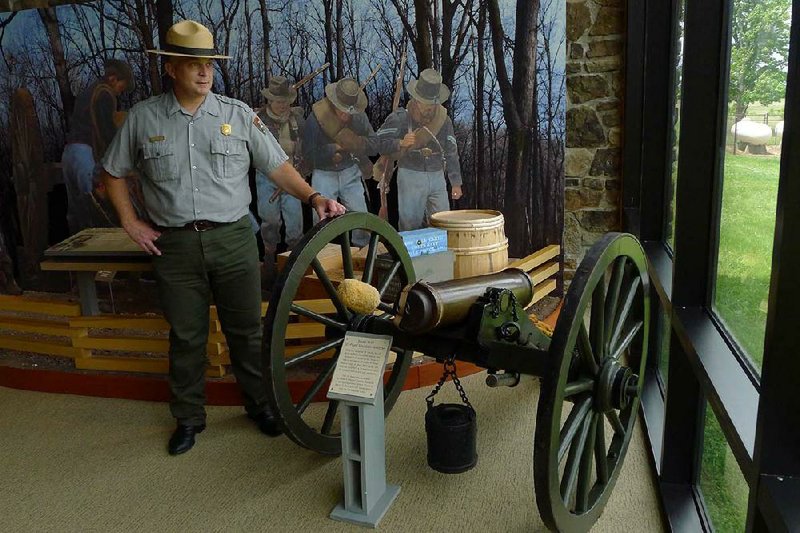PEA RIDGE -- There are too many cedar trees at Pea Ridge National Military Park. And not enough corn.
That's compared with 1862, when the Battle of Pea Ridge secured Missouri for the Union and opened Arkansas to Union occupation.
Back then, there wasn't a cedar tree around, said Kevin Eads, the park's chief of resources management. Now, eastern red cedar trees cover 759 acres of the 4,300-acre park. And red oaks have proliferated, crowding the black, white and post oaks that dominated the forest a century ago.
Occasionally, history buffs visit the park and comment on how the vegetation is different than it was 150 years ago, Eads said. Visualizing the battle requires an extra feat of imagination, but park officials want to make that easier on the park's 100,000 yearly visitors.
To restore the appearance of the landscape to that of 1862, they've come up with a Vegetation Management Plan with three alternatives.
Among other things, all three alternatives call for re-establishing more of the vegetation that would have existed at the time of the 1862 battle and preserving old trees that were growing on the battlefield at that time. Sixteen trees that are at least 152 years old have been identified so far.
All three alternatives also call for removing the vast majority of cedar trees, reducing them from 759 acres to fewer than 10 acres.
All alternatives also call for thinning open woodlands (currently 345 acres) and dense forests (currently 2,625 acres), and re-establishing a total of 900 acres of open woodlands that were absorbed by the expanding forests. Open woodlands are low-density forests in which the tree canopy allows sunlight to reach the ground.
An alternative known as "B" would emphasize the cultural nature of the park by re-establishing specific crops, orchards, pastures and open woods that would have existed at the time of 1862 battle. An alternative known as "D" would incorporate primarily native vegetation to visually represent the openness of the fields and surrounding woods that would have existed in 1862, but no crops would be planted.
Park officials prefer an alternative known as "C" that would combine "B" and "D," for example, by planting corn in some areas but not all fields that existed in 1862, Eads said. Restoring all the cornfields would obstruct the view of the battlefield in summer, when corn is tall and when most visitors go to the park. The battle occurred in early March, when the cornfields were full of dry stalks jutting from the ground.
"Alternative B is taking more of a literal 1862 look," said Eads. "Alternative C is taking that 1862 look but blurring the edges a little bit to allow you to better manage for the long-term. Some things are going to look real close, dead on. Others, not so much. But that's where interpretation gets involved."
The Vegetation Management Plan and Environmental Assessment -- an extension of the park's 2006 General Management Plan -- is open for public review. The comment period began May 22 and will continue through June 21.
The Vegetation Management Plan will be integrated with a Cultural Landscape Report that is also open for public review through June 21.
That plan will provide guidance for preserving cultural aspects of the battlefield site.
Both plans can be viewed at parkplanning.nps.gov/parkHome.cfm?parkID=159. Comments can be left via the website or mailed to Superintendent John C. Scott, Pea Ridge National Military Park, 15930 U.S. 62 East, Garfield, Ark., 72732.
Eads wouldn't estimate the cost of the various options in the Vegetation Management Plan.
The park has natural resources that could offset costs for the project, depending on the option chosen, said Eads. Cornfields and hayfields could be leased to farmers.
Also, red oak trees could be harvested to make fence rails for the park. There are 15 miles of wood fences in the park and 38 separate fields.
The forest has become more dense since 1956, when Congress passed a law creating Pea Ridge National Military Park, and most farming operations there stopped, said Eads.
To research the vegetation at the park, Eads and others compared General Land Office survey records from 1836 and 1837 to records during the Civil War.
According to the study, in 1862, the park area was 63 percent open woodlands, 24 percent Arkansas highland forests (but no eastern red cedar trees) and 11 percent fields. Prairies, orchards and glades accounted for the rest.
Now, the park is 18 percent eastern red cedar trees, 61 percent other Arkansas highland forest trees, 11 percent fields and 8 percent open woodlands, according to the study. Prairies and visitor areas account for the rest.
In 1862, the park was made up of 37 percent post oak trees, 26 percent black oaks, 18 percent blackjack, 12 percent white oaks, 2 percent hickory and 1 percent red oaks, according to the study.
A park study identified five areas of eastern red cedar trees, some of which are 101 years old and others that are 70 years old. Fire suppression contributed to the abundance of cedars, said Eads.
A public meeting will be held on both plans at 6 p.m. Thursday in the Northeast Benton County Fire Department conference room in Garfield.
Metro on 06/02/2014

